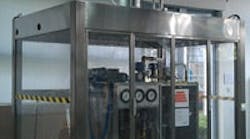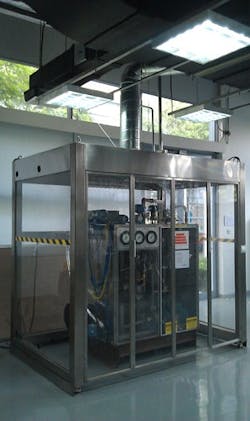The global heat transfer fluid (HTF) market is hot. By 2017 its value will reach $2.56 billion, a rise of almost $1 billion from 2011. So says market researcher MarketsandMarkets, Dallas, in a new report.
Published on November 24, 2012, "Global Heat Transfer Fluid (Thermic Fluid/High Temperature/Synthetic Heat Transfer Fluids) Market — by Product Type (Mineral Oils, Silicone & Aromatics, PAG & Glycol Based Products & Others), Application & Geography — Forecasts to 2017" notes that Dow, ExxonMobil, Shell and Solutia (now part of Eastman Chemical) accounted for 76% of the market in 2011. It goes on to say that demand in the chemical industry for HTFs with greater thermal and oxidation stability will increase significantly over the next six years.
One such demand is coming from reaction cooling, a trend noted by Air Products, Allentown, Pa. "We are using liquid nitrogen (LIN) to cool HTFs as low as -90°C. There is even a trend now to go colder, even down to -120°C. This represents a challenge because it's difficult to get many HTFs to operate at this temperature," notes John Tremblay, technical manager, cryogenic applications, Basingstoke, U.K.
Such low temperatures cause viscosity problems with many traditional HTFs and thus require vendors to adjust their formulations accordingly. However, vendors often can't easily get down to the required temperatures in their own laboratories. In response, Air Products has built a test rig that evaluates the performance of different HTFs in a pilot-scale heat exchanger.
"It's rated at 10 kW at -90°C. We've tested five or six different fluids on it. There is a definite move away from methanol and other solvents to silicone fluids and other lower-flammability-risk fluids," says Tim Boland, research associate, cryogenics, Allentown.
"Companies that produce HTFs often want us to do testing for them. Also, it's important for us when we get a new enquiry from a manufacturer to be able to show that we can cool their HTFs without freezing them and causing all the associated process problems," adds Tremblay.
Although originally constructed in Allentown, the rig currently is operating at Air Products' technology center in Shanghai, China (Figure 1).
Users wanting a single HTF that can handle many different, often multi-step processes is another trend Air Products notices. "So, the pressure is on us to deliver LIN cooling that will achieve this and we have done a lot of testing on it," says Tremblay.
Customers scaling up from bench to pilot to full-scale production also are turning to Air Products. "Along the way they typically change cooling technology from flammable-solvent-type solutions, such as acetone/dry ice, to more production-friendly HTFs. They often need our expertise when it comes to choosing the best HTF for these scaleups," explains Boland.
A good example of this, he says, is when custom fine chemical houses want to extend their product lines but don't have the knowledge or experience to operate below their typical -20°C lowest temperature. Here, Air Products can offer support such as showing how to run reactors at much colder temperatures.
LIN itself offers a very attractive pricing strategy for many customers because it's a variable cost, for example when used by toll manufacturers, Tremblay contends. "LIN can also get to lower temperatures than many much more expensive mechanical refrigeration processes," he notes. LIN has further appeal, too. First, its associated plant is simple to operate and easy to maintain. Second, costs can be further offset by recycling and using it for other applications, such as inerting and blanketing.
In terms of the market, Air Products is seeing more companies who traditionally use refrigerants moving to HTFs and particularly to the more robust silicone oils.
"The market is moving from flammable HTFs to combustible HTFs to non-combustible HTFs. Concerns over health and safety and the environment are driving this, along with lower temperature processes," says Boland.
Tremblay believes future developments will involve smaller, more efficient plants capable of leaner processing: "The reaction kinetics here could get more volatile, generate more heat and therefore need more cooling."
For Boland, growing environmental awareness in Asia is important. "We are already seeing a much greater use of low temperature condensation technology in China, for example."
EXTENDING THE RANGE
Meanwhile, in response to demand for HTFs suitable for higher temperatures, Paratherm, West Conshohocken, Pa., has added to its portfolio two new aromatic-based HTFs for closed-loop liquid-phase heating: Paratherm GLT for use up to 288°C and Paratherm HR, which is good to 343°C in fired heaters and 357°C in waste-heat-recovery and full convection heaters.
Increasing demand from the biomass fuel industry, which uses even higher temperatures in its processes, is prompting the company to work on other new HTF formulations.
At the other end of the temperature scale, Paratherm also is keeping busy. When Bedoukian Research, Danbury, Conn., a maker of aroma and flavor ingredients, needed to expand its product line, lower temperature processing became even more of a critical issue. "We were looking for a long time to find a thermal fluid that would do what we need it to do," says general manager Greg Pignone.
Bedoukian uses a range of 50–200-gallon reactors to manufacture its products and needed cooling down to -60°C. The company chose Paratherm CR HTF.
"Many fluids used for cooling thicken or even freeze up below a certain point, usually at -50°C to -60°C. Paratherm CR doesn't do that. It allowed us to use colder temperatures," notes Pignone.
Since the changeover, Bedoukian has achieved higher yields and cut production time by more than 50% for batches. "We are able to run some of our cooled chemical reactions twice as fast now, and run at much lower temperatures than before with better heat transfer. This opens the door for us to produce custom syntheses that we couldn't have attempted before," he adds.
Customers are asking for more than just fluids suitable for extended temperatures, explains Paratherm's technical director Jim Oetinger. "There has been a trend for more after-sales support over the last eight or nine years and this has really accelerated over the last couple of years — mainly because maintenance has been skinned to the bone. A lot of expertise has been lost, particularly on the older equipment. Much of our support today is to do with planned maintenance; because the in-house experience has gone, the queries and requests are coming back to suppliers."
As part of its service package, Paratherm always has included an annual HTF test for customers. For many this simply involved sending in a sample of their HTFs. Today, the company is getting many more "what if?" type calls. "The audience is a lot more receptive to what we have always been saying about maintenance — that it's better to have a quarter of a day of maintenance every year than weeks of outage through breakdown. This equipment should run for years, not months," notes Oetinger.
At the same time, insurance companies are taking a tougher stance on fire issues. "We do hear about fires from time to time and there have been more of them recently. But the National Fire Protection Association (NFPA), Quincy, Mass., has put out a recommended practice for fluid heaters (NFPA 87), so clearly this problem is being recognized."
NFPA 87 covers, e.g., thermal fluid heaters and process fluid heaters in which the fluid is flowing, under pressure, and is indirectly heated.
"Up to now there have really been no national standards for fluid heaters, with people relying on information from the suppliers. Now the insurance companies are looking at the NFPA guidance and requiring users to meet the standard," he adds.
LIFECYCLE FOCUS
Service also plays a key role at Solutia, St. Louis, Mo., now a subsidiary of Eastman Chemical, Kingsport, Tenn. The company's Total Lifecycle Care (TLC) program long has been a cornerstone of its Therminol HTF business.
"The TLC program offers a suite of services to support the use of Therminol heat transfer fluids throughout their entire lifecycle, from design to startup to operation and maintenance," says Ravi Prakash, global business director.
To emphasize the importance of such services, Prakash points to a recent project success in Brazil at Resitol Indústria Química, Palmeira. The company is a major producer of crude sterol from tall oil extracted from byproducts of pulp and paper production.
Resitol uses a high-vacuum molecular distillation unit to extract sterol from the tall oil. The company relies on a secondary coolant fluid (SCF) rather than costlier direct cooling to achieve -70°C, a temperature necessary to maximize separation efficiency and reduce product degradation.
Following two leaks of SCF from its heat transfer system and the inability of its fluid supplier to replenish the missing material in a timely manner, Resitol contacted the local Solutia team. After discussions between the team and Resitol engineers, the existing silicone-based fluid was switched to Therminol LT, a synthetic aromatic HTF that can be used in both the liquid and vapor phase between -70°C and 315°C.
"Our local Solutia Therminol engineers provided us with comprehensive guidance for draining our old fluid, flushing the system and refilling with the new Therminol LT. They also provided on-site support as needed throughout the process until the system was started up. We have never received this level of expert support with our previous supplier. They also have local stock in case of emergencies," notes Resitol maintenance and production manager Charles Souza.
Solutia boasts a 16-strong family of synthetic fluids for indirect heating or cooling over a broad range of temperatures and applications. At one end of the temperature scale is Therminol VLT, which is aimed at single-fluid heating and cooling systems between -115°C and 175°C. At the other end is Therminol VP-1, a synthetic HTF for vapor phase systems from 257°C to 400°C, or liquid phase systems from 12°C to 400°C.
"Our flagship products, Therminol 55, Therminol 66 and Therminol VP-1, serve diverse and dynamic end markets that change from year to year. Two markets that are strong for us now are the oil and gas market and the concentrating solar power market," adds Prakash.




